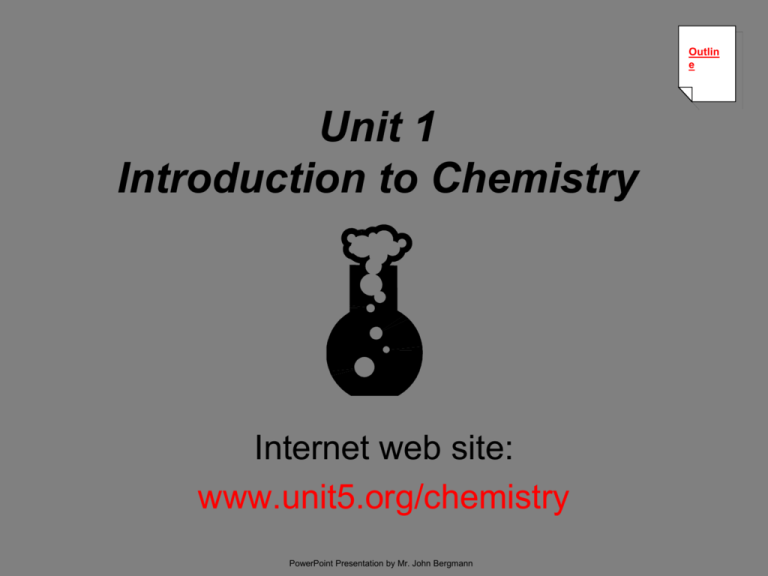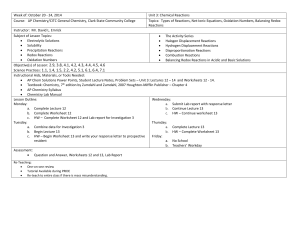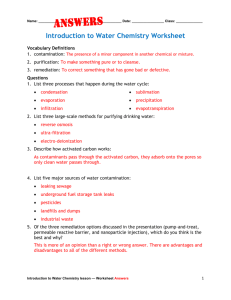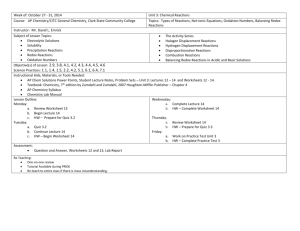Unit 1 Introduction to Chemistry
advertisement

Outlin e Unit 1 Introduction to Chemistry Internet web site: www.unit5.org/chemistry PowerPoint Presentation by Mr. John Bergmann Safety Basic Safety Rules #1 Rule: Use common sense. Others: No horseplay. No unauthorized experiments. Handle chemicals/glassware with respect. Safety Features of the Lab safety shower fire blanket fire extinguisher eye wash fume hood circuit breaker switch Material Safety Data Sheet (MSDS) -- gives information about a chemical -- lists “Dos” and “Don’ts;” emergency procedures Chemical Exposure acute exposure a one-time exposure causes damage e.g., reaction to drugs or medication chronic exposure damage occurs after repeated exposure e.g., smoking, asbestos LD50 the lethal dosage for 50% of the animals on which the chemical is tested There are various ways an LD50 can be expressed. For example, acetone has the following LD50s: ORL-RAT LD50: 5,800 mg/kg IHL-RAT LD50: 50,100 mg/m3-h SKN-RBT LD50: 20 g/kg Example Chemical A: LD50 = 3.2 mg/kg Chemical B: LD50 = 48 mg/kg Which is more toxic? Chemical A is more toxic because less of it proves fatal to half of a given population. Science The Functions of Science pure science applied science the search for knowledge; facts using knowledge in a practical way e.g., aluminum strong lightweight good conductor Science attempts to establish cause-effect relationships. risk-benefit analysis weigh pros and cons before deciding Because there are many considerations for each case, “50/50 thinking” rarely applies. How does scientific knowledge advance? 1. curiosity 2. good observations 3. determination 4. persistence The Scientific Method Parts of the Scientific Method Identify an unknown. Make a hypothesis: an educated testable prediction Repeatedly experiment to test hypothesis. procedure: order of events in experiment (i.e., a recipe) variable: any factor that could influence the result A Scientific Experiment Experiments must be controlled: they must have two set-ups that differ by only one variable conclusion: must be based on the data ** Key: Be a good observer. observation uses the five senses inference involves a judgment or assumption Types of Data Observations are also called data. qualitative data -- descriptions e.g., clear liquid quantitative data -- measurements e.g., 55 L or 83oC Scientific Law vs. Scientific Theory law: states what happens -- does not change -- never violated -- e.g., law of gravity, laws of conservation theory: tries to explain why or how something happens -- based on current evidence -- e.g., Atomic Theory Phlogiston Theory of Burning 1. Flammable materials contain phlogiston. 2. During burning, phlogiston is released into the air. 3. Burning stops when… …object is out of phlogiston, or …the surrounding air contains too much phlogiston. (superceded by combustion theory of burning) Chemistry The Beginning early practical chemistry: household goods, weapons, soap, wine, basic medicine The Greeks believed there were four elements. ___ ___ D D earth wind fire ~ water D Alchemy (~500 – 1300 C.E.) the quest for the Philosopher’s Stone (the elixir, the Sorcerer’s Stone) Allegedly, this substance would turn cheap metals into gold. Alchemical symbols for substances… GOLD SILVER COPPER IRON . .. ... .... ..... SAND transmutation: changing one substance into another Philosopher’s Stone COPPER GOLD In ordinary chemical reactions…we cannot transmute elements into different elements. Alchemy was practiced in many regions of the world, including China and the Middle East. Alchemy arrived in western Europe around the year 500 C.E. Modern chemistry evolved from alchemy. Contributions of alchemists: • experimental techniques • new glassware • information about elements • developed several alloys What is Chemistry? the study of matter and its changes Areas of Chemistry organic the study of carboncontaining compounds inorganic studies everything except carbon e.g., compounds containing metals biochemistry the chemistry of living things physical measuring physical properties of substances e.g., the melting point of gold Careers in Chemistry • • • • • • research (new products) production (quality control) development (manufacturing) chemical sales software engineering teaching The skills you will develop by an earnest study of chemistry will help you in any career field. The Scope of Chemistry bulk chemical manufacturing acids, bases, fertilizers **sulfuric acid (H2SO4) = #1 chemical petroleum products fuels, oils, greases, asphalt pharmaceuticals 1 in 10,000 new products gets FDA approval synthetic fibers nylon, polyester, rayon , spandex All fields of endeavor are affected by chemistry. Government Regulation of Chemicals worker OSHA environment EPA The government regulates chemicals to protect the… FDA USDA FAA CPSC consumer Manipulating Numerical Data Graphs Bar Graph shows how many of something are in each category Chemistry Grades # of students 10 8 6 4 2 0 A B C D F Pie Graph shows how a whole is broken into parts Percentage of Weekly Income Entertainment (40%) Food (25%) Clothing (20%) Savings (15%) Line Graph shows continuous change Stock Price over Time Share Price ($) 60 50 40 30 20 10 0 Jan Feb Mar Apr Month In chemistry…you will always use a line graph. Elements of a “good” line graph Temp. v. Vol. for a Gas at Constant Pressure 2. axes labeled, with units 3. neat 4. use the available space Volume (L) 1. title 10 9 8 7 6 5 4 3 2 1 0 120 140 160 180 200 Temp. (K) 220 240 Essential Math of Chemistry Scientific Notation -- used to express very large or very small numbers, and/or to indicate precision (i.e., to maintain the correct number of significant figures) Form: (# from 1 to 9.999) x 10exponent 800 = 8 x 10 x 10 = 8 x 102 2531 = 2.531 x 10 x 10 x 10 = 2.531 x 103 0.0014 = 1.4 10 10 10 = 1.4 x 10–3 Put in standard form. 1.87 x 10–5 = 0.0000187 3.7 x 108 = 370,000,000 7.88 x 101 = 78.8 2.164 x 10–2 = 0.02164 Change to scientific notation. 12,340 = 1.234 x 104 0.369 = 3.69 x 10–1 0.008 = 8 x 10–3 1,000,000,000 = 1 x 109 6.02 x 1023 = 602,000,000,000,000,000,000,000 Using the Exponent Key EE EXP The EE or EXP or E key means “times 10 to the…” How How to to type type out out 6.02 6.02 xx10 102323:: 6 0 . 2 EE 2 3 not… WRONG! 6 0 . yx 2 2 3 or… 6 WRONG! . 0 2 x 1 and not… 6 . 0 EE 2 3 TOO MUCH WORK. 0 2 x 1 0 yx 2 3 Also, know when to hit your (–) sign. (before the number, after the number, or either one) 1.2 x 105 2.8 x 1019 Type this calculation in like this: 1 . 2 EE 5 2 . 8 EE 1 9 = Calculator gives… 4.2857143 –15 or… 4.2857143 E–15 This is NOT written… 4.3–15 But instead is written… 4.3 x 10–15 or 4.3 E –15 7.5 x 10–6 (–8.7 x 10–14) = –6.5 x 10–19 4.35 x 106 (1.23 x 10–3) = 5.35 x 103 or 5350 (5.76 x 10–16) (9.86 x 10–4) = (8.8 x 1011) x (3.3 x 1011) = 5.84 x 10–13 2.9 x 1023 Essential Math of Chemistry Units must be carried into the answer, unless they cancel. 5.2 kg (2.9 m) = 0.64 kg.m (18 s)(1.3 s) s2 4.8 kg (23 s) (18 s)(37 s) = 0.17 kg s Solve for x. x+y=z x and y are connected by addition. Separate them using subtraction. In general, use opposing functions to separate things. x+y=z –y –y The +y and –y cancel on the left, leaving us with… x=z–y Numerical Example Solve for x. x – 24 = 13 x and 24 are connected by subtraction. Separate them using the opposite function: addition. x – 24 = 13 +24 +24 The –24 and +24 cancel on the left, leaving us with… x = 37 Solve for x. x and k are connected by multiplication. Separate them using the opposite function: division. The two k’s cancel on the right, leaving us with… F=kx () () __ 1 __ 1 F=kx k k (or) F=kx k k __ F x= k Numerical Example Solve for x. x and 7 are connected by multiplication. Separate them using the opposite function: division. The two 7’s cancel on the right, leaving us with… 8=7x () () __ 1 __ 1 8=7x 7 7 (or) 8=7x 7 7 __ 8 x= 7 Solve for x. One way to solve this is to cross-multiply. Then, divide both sides by TR. The answer is… ___ BA = ___ TR x H BAH = xTR ( ) ( ) ___ 1 BAH = xTR ___ 1 TR TR BAH x = ___ TR Solve for T2, where… P P 1V1 2V 2 ____ ____ = P1 = 1.08 atm T1 T2 P2 = 0.86 atm ____ 1 1 V1 = 3.22 L P1V1T2 = P2V2T1 ____ P1V1 P1V1 V2 = 1.43 L T1 = 373 K P2V2T1 ______ ( ) ( ) T2 = P1V1 (0.86 atm)(1.43 L)(373 K) _____________________ T2 = = 130 K (1.08 atm)(3.22 L) SI Prefixes kilodecicentimilli- (k) (d) (c) (m) 1000 1/ 10 1/ 100 1/ 1000 Also, 1 mL = 1 cm3 and 1 L = 1 dm3 Conversion Factors and Unit Cancellation How many cm are in 1.32 meters? equality: 1 m = 100 cm (or 0.01 m = 1 cm) conversion factors: ______ 1m 100 cm or ( 100 cm ______ 1m ) 100 cm = 132 cm 1.32 m ______ 1m We use the idea of unit cancellation to decide upon which one of the two conversion factors we choose. How many m is 8.72 cm? equality: 1 m = 100 cm conversion factors: ______ 1m 100 cm or ( 100 cm ______ 1m ) 1m 8.72 cm ______ = 0.0872 m 100 cm Again, the units must cancel. How many kilometers is 15,000 decimeters? ( )( 1m 15,000 dm ____ 10 dm ) 1 km ______ = 1.5 km 1,000 m How many seconds is 4.38 days? ( )( 24 h 4.38 d ____ 1d )( ) 60 min _____ 1h 60 s ____ = 378,432 s 1 min If we are accounting for significant figures, we would change this to… 3.78 x 105 s Simple Math with Conversion Factors Find area of rectangle. 4.6 cm A=L.W = (4.6 cm)(9.1 cm) = 42 9.1 cm 2. cm cm Convert to m2. cm.cm 1m 42 cm2 ______ 100 cm ( ) = 0.0042 m2 ( ) = 4200 mm2 10 mm Convert to mm2. 42 cm2 ______ 1 cm 2 2 For the rectangular solid: Length = 14.2 cm Width = 8.6 cm Height = 21.5 cm Find volume. V=L.W.H = (14.2 cm)(8.6 cm)(21.5 cm) = 2600 cm3 Convert to mm3. 2600 cm3 ( ) 10 mm ______ 1 cm 3 = 2,600,000 mm3 = 2.6 x 106 mm3 mm and cm differ by a factor of………. 10 mm2 “ cm2 “ “ “ “ “ ………. 100 mm3 “ cm3 “ “ “ “ “ ………. 1000 Basic Concepts in Chemistry chemical: any substance that takes part in, or occurs as a result of, a chemical reaction All matter can be considered to be chemicals or mixtures of chemicals. chemical reaction: a rearrangement of atoms such that… “what you end up with” products differs from “what you started with” reactants carbon methane + oxygen + water dioxide CH4(g) + 2 O2(g) CO2(g) + 2 H2O(g) sodium + water hydrogen + sodium hydroxide 2 Na(s) + 2 H2O(l) H2(g) + 2 NaOH(aq) Law of Conservation of Mass total mass total mass = of products of reactants Pmass = Rmass synthesis: taking small molecules and putting them together, usually in many steps, to make something more complex JENNY How many feet is 39.37 inches? equality: 1 ft = 12 in applicable conversion factors: ______ 1 ft 12 in X ft = 39.37 in or ______ 12 in 1 ft ( ) ____ 1 ft = 3.28 ft 12 in Again, the units must cancel. Resources - Intro. to Chemistry Worksheet - vocabulary Worksheet - material safety data sheet (acetone) Activity - checkbook activity Worksheet - graphing Worksheet - real life chemistry Worksheet - conversion factors Worksheet - scientific notation Worksheet - metric article (questions) Episode 1 - The World of Chemistry Worksheet - significant digits Episode 3 – Measurement: The Foundation of Chemistry Worksheet - math review Episode 4 - Modeling The Unseen Worksheet - math of chemistry Worksheet - article on the metric system Textbook - questions Lab – introduction to qualitative analysis Outline (general)





